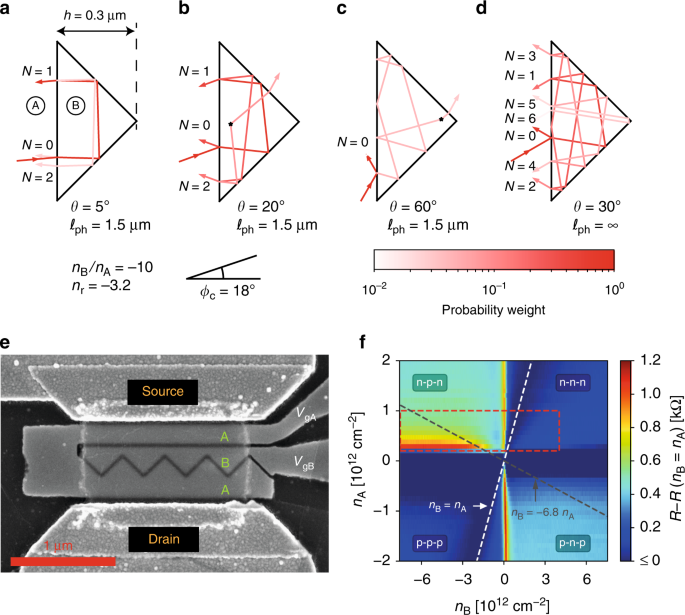

These two Fano resonances interfere to form comb-like transmissions in the DBR band gap, that is, the transmission comb. We attribute this to the fact that the bottom grating also generates Fano resonances that are coherent with those generated by the top grating. However, when another surface grating is added on the bottom of the DBR, almost symmetric resonant transmission peaks appear at the positions of the previous Fano resonances with peak transmissivities of 100%. The effects of the Fano resonances depend on the transmissivity of the incident waves, being weaker in the DBR band gap owing to the low transmissivity. Hence, the asymmetric Fano line shapes are the result of the coupling between the continuous transmission mode of the DBR and the discrete grating-induced Bloch levels at the point. In the present structure, they appear in the DBR band gap and play the role of the discrete level in the Fano resonance. When the incident light is normal to the surface, the grating-induced optical Bloch states at the point (where the transverse wave vector is zero) are discrete. When the top surface grating is added, asymmetric line shapes appear (red lines), which can be explained in the Fano picture 2, 22. The black lines refer to the common DBR with a band gap between 860 nm and 940 nm. įigure 2(a,b) show the transmission spectra of the TE and TM waves. The proposed structure could be fabricated by routine etching of the bottom grating on the substrate, then depositing the DBR and finally etching the top grating.Īnd then the transmissivity and reflectivity. Without loss of generality, the medium above and below the DBR is set to be air with refractive index. We also assume that the GaAs gratings on top and bottom coincide in the horizontal direction and have the same height, width, period and thus duty cycle. We assume that the DBR has layers of GaAs and layers of AlAs, totalling to layers for the structure in Fig. The DBR consists of GaAs and AlAs layers with heights of and and refractive indices of and 25, respectively. In the present work, the two gratings are introduced to adjust the transmission spectrum in the DBR band gap centered at wavelength nm. Grating geometries have been applied in many kinds of optical structures to enhance or change the device properties 2, 15, 16, 22, 23, 24. The G/DBR/G allows us to achieve a multichannel optical filter, simultaneously with a size reduction.

In the G/DBR/G there is no cavity layer similar to that contained in the Fabry-Pérot cavity 18. We refer to this sandwich structure as G/DBR/G and to the DBR with only one surface dielectric grating as G/DBR. We consider an optical structure consisting of a DBR with two identical dielectric gratings on top and bottom, as shown in Fig.

Also, the transmission combs are robust against randomness in the heights of the DBR layers, which is a key advantage. In particular, we achieve a comb-like transmission spectrum in the DBR band gap that is appropriate for optical filters and polarizers with ultra-narrow transmission bands. We propose an approach to avoid this requirement. As a result, the cavity layer thickness must be much larger than the photon wavelength. Since the transmission peaks are located in the band gap of the DBR, a small peak separation in the comb-like transmission is required. As compared to frequency combs, the comb-like transmission also has substantial advantages in optical frequency metrology 19, broadband gas sensing 20 and molecular fingerprinting 21. In this case, the semiconductor microcavity can serve as a multichannel optical filter. When the cavity layer is thick enough, the transmission of the semiconductor microcavity is comb-like with the peak separation being roughly inversely proportional to the thickness, namely, the distance between the two DBRs 4. Narrow-band filters can be realized by a semiconductor microcavity that consists of two DBRs and one cavity layer 17, 18. The most important applications of the DBR are optical switches 10, 11, lasers 12, 13, 14, sensors 15, couplers 3 and narrow-band filters 2, 4, 16. It attracts plenty of attention due to its high tunability and extensibility, which can be enhanced by introducing additional structures, for example, defects and gratings. A distributed Bragg reflector (DBR) is an important element widely used in optics 1, 2, 3, 4, 5, photonics 6, 7, 8, solar cells 9 and other fields.


 0 kommentar(er)
0 kommentar(er)
